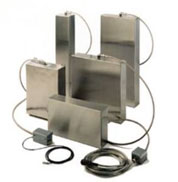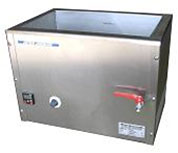Ultrasonic CleaningUNITECH offers a wide range of stand alone and replacement ultrasonic units for new and existing equipment. A bracket mounting system is also offered which enables ultrasonic agitation to be applied to an existing bath without having to physically dismount and modify the tank in question (see the technical file for details). Ultrasonic cleaning is used in numerous sectors (such as the mechanical industry, watch-making, the optical industry and industrial processing) for decontaminating, degreasing, de-scaling or simply cleaning parts. This process uses mechanical energy generated by cavitation. When a liquid is subjected to sufficiently intense ultrasonic waves, tiny gas bubbles are formed. When these bubbles implode, localized pressure reaching up to a thousand atmospheres is produced. If situated close to foreign matter stuck to an object, the pressure will cause the foreign matter to be violently detached from the soiled object. Energy generated by ultrasonic cavitation produces several effects that lead to :
Ultrasonic cleaning offers several advantages over conventional processes. The microscopic cavitation bubbles are able to clean irregular surfaces and complex parts (such as holes, blind holes and parts not yet machined to completion) without leaving brush marks while eliminating the need for complex manipulations. Ultrasonic agitation also works more quickly and more thoroughly than conventional processes which may or may not use chemical agents depending on the soiling to be removed. In addition, the electronic controls and automated nature of ultrasonic cleaning make it a reliable method whose results can be successfully repeated in the future. In general, the level of ultrasonic power used is between 10 and 20 W/litre per bath for low ultrasonic frequencies (25 to 40 kHz). The level of ultrasonic frequency helps determine the size of cavitation bubbles and the intensity at which they will implode. To obtain the desired cleaning results, the following parameters must be taken into consideration:
|





